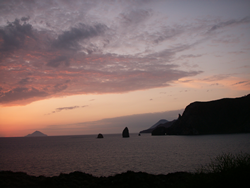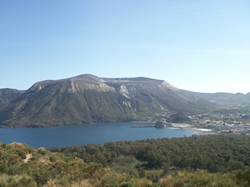
 Vulcano is the nearest island to Sicily, from which it's only 18 miles far.
It is formed mainly by two cones: Vulcanello, whose origins go back approximately to 200 years ago, and the Great Crater of the Fossa, still considered in activity from the scientists and under regular observation. The eruptive activity of the main crater has been intense, with more or less long stops. The most recent and the last period of activity had begun in 1888 and stopped in 1890, characterized by the launch of bullets of effusive material of great dimensions. From that time the volcano remained almost the same, limited to the single fumarole activity.
The island in its circumference presents various coves for the variety and the beauty of the landscapes. The slopes of the volcano, like good part of the island, are covered from a rich vegetation where prevails a particular type of Ginestra, typical of the Aeolian Archipelago and of the Ponziane islands. In summer, in fact, the island is covered by a variety of colours jus for this magnificent fauna. In the zone of the port there is a thermal source useful for its therapeutic property. Many coves dug in the tufo, called Coves of the Red ones, let to suppose that the holiness of the place derived from the custom to bury the dead men close to the god Volcano so to make easier the passage to the afterlife. Vulcano is the nearest island to Sicily, from which it's only 18 miles far.
It is formed mainly by two cones: Vulcanello, whose origins go back approximately to 200 years ago, and the Great Crater of the Fossa, still considered in activity from the scientists and under regular observation. The eruptive activity of the main crater has been intense, with more or less long stops. The most recent and the last period of activity had begun in 1888 and stopped in 1890, characterized by the launch of bullets of effusive material of great dimensions. From that time the volcano remained almost the same, limited to the single fumarole activity.
The island in its circumference presents various coves for the variety and the beauty of the landscapes. The slopes of the volcano, like good part of the island, are covered from a rich vegetation where prevails a particular type of Ginestra, typical of the Aeolian Archipelago and of the Ponziane islands. In summer, in fact, the island is covered by a variety of colours jus for this magnificent fauna. In the zone of the port there is a thermal source useful for its therapeutic property. Many coves dug in the tufo, called Coves of the Red ones, let to suppose that the holiness of the place derived from the custom to bury the dead men close to the god Volcano so to make easier the passage to the afterlife.
The history
 From the observation of a physical map, it can be noticed the three main reliefs emerging, the craters that have constituted the island: the one more to the south, ancient, is extinguished since the preistorical times and has formed the elevated top; the Mount Aria, that catches up the 149 meters and it has on its peeks the greater part of the existing houses on the island; concerning the other relief (391 m.) it is called Great Crater and it alternates period of activity to periods of quietness: the third relief, Vulcanello, is younger than the first ones, emerged from the sea in the 183 a.C. , making, such as Plinio told, a great massacre of fishes. In origin this relief constituted one small island to itself. Later on it was joined to Vulcano and formed with it a small istmo and it has created two bays with two beaches of black sand.
The island derives its name from intense volcanic activity and still manifested from the presence of the “fumarole”, exhalation of high temperature of watery vapour, sulphur and carbon dioxide that are given off from the crater and the fissures of the terrace so the air smells of an acrid scent of sulphur. Probably, due to these phenomenas, the Greeks and the Romans consecrated it to the god of the fire, Efesto for the first ones and Vulcano for the second ones. Till the times of ancient Greece, the island of Vulcano has been called Hierà, that means “sacred”, but also Thermessa , meaning “warm”, for the volcanological phenomenas that gives to the ground its warmness in all the seasons. From the observation of a physical map, it can be noticed the three main reliefs emerging, the craters that have constituted the island: the one more to the south, ancient, is extinguished since the preistorical times and has formed the elevated top; the Mount Aria, that catches up the 149 meters and it has on its peeks the greater part of the existing houses on the island; concerning the other relief (391 m.) it is called Great Crater and it alternates period of activity to periods of quietness: the third relief, Vulcanello, is younger than the first ones, emerged from the sea in the 183 a.C. , making, such as Plinio told, a great massacre of fishes. In origin this relief constituted one small island to itself. Later on it was joined to Vulcano and formed with it a small istmo and it has created two bays with two beaches of black sand.
The island derives its name from intense volcanic activity and still manifested from the presence of the “fumarole”, exhalation of high temperature of watery vapour, sulphur and carbon dioxide that are given off from the crater and the fissures of the terrace so the air smells of an acrid scent of sulphur. Probably, due to these phenomenas, the Greeks and the Romans consecrated it to the god of the fire, Efesto for the first ones and Vulcano for the second ones. Till the times of ancient Greece, the island of Vulcano has been called Hierà, that means “sacred”, but also Thermessa , meaning “warm”, for the volcanological phenomenas that gives to the ground its warmness in all the seasons.
|